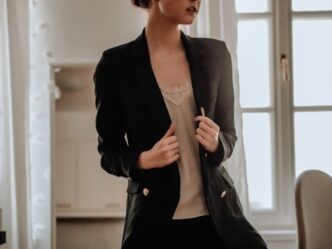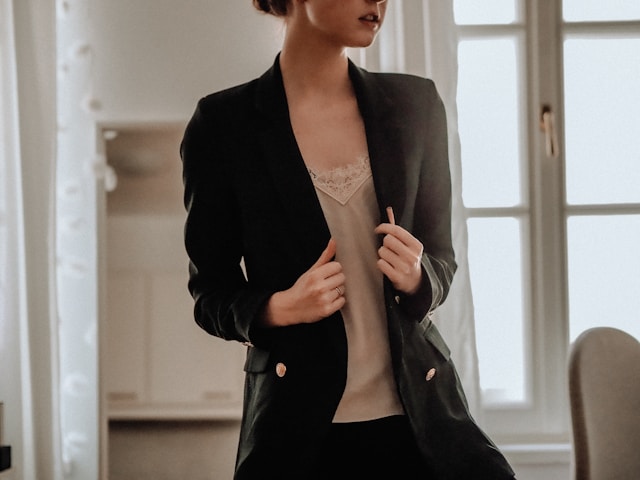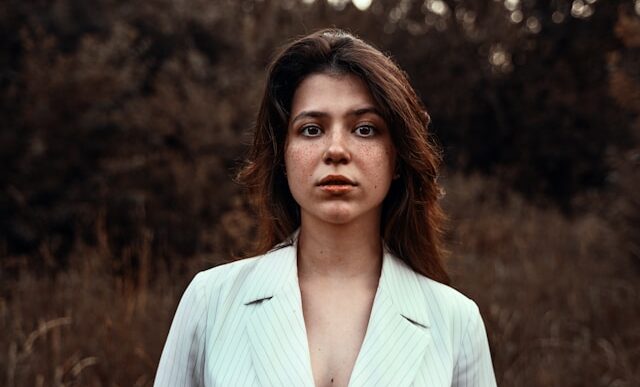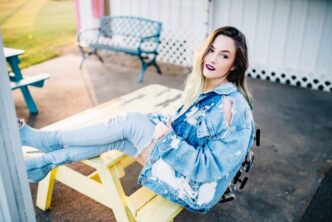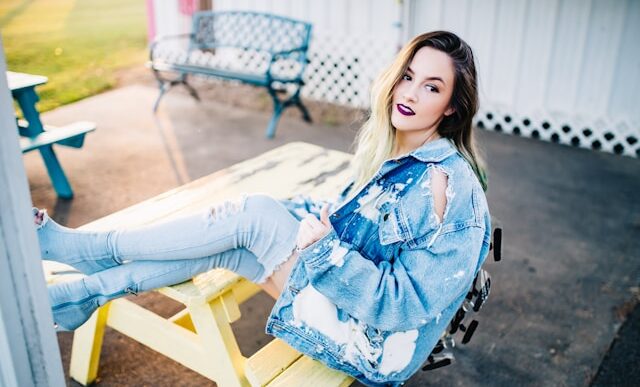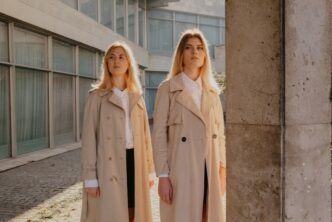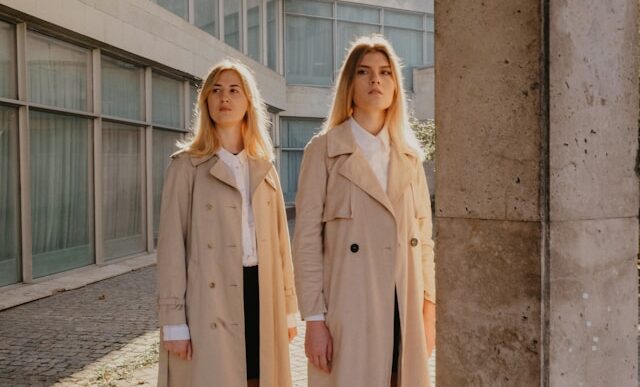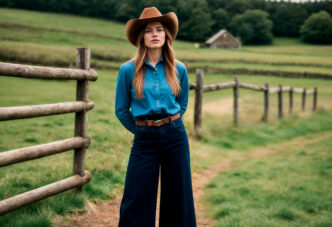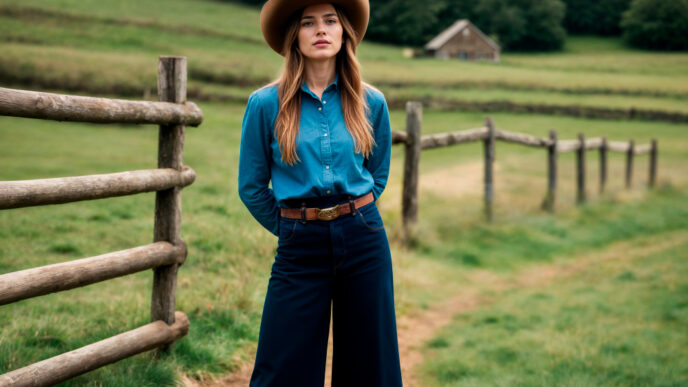Blazers are versatile wardrobe essentials that work across all seasons. These structured pieces transform any outfit from casual to polished. Understanding how to style blazers opens countless possibilities for modern women. This guide covers various approaches to wearing these timeless garments. From office meetings to weekend brunches, blazers adapt to different settings with ease. The key lies in selecting the right fit and pairing it with complementary pieces.
Top 10 Blazer Outfit Ideas
Creating polished looks with structured jackets requires thoughtful coordination of colors, textures, and proportions that enhance the blazer’s sophisticated appeal.
Blazer with Jeans
Pairing blazers with denim creates effortless smart-casual looks. This combination works perfectly for weekend activities and casual business meetings. Choose dark wash jeans for a more polished appearance. The contrast between structured tailoring and casual denim strikes the perfect balance.
Blazer outfit for women often features denim for its versatility and comfort. Tuck in a simple white tee or blouse to create clean lines. Add pointed-toe flats or ankle boots depending on the occasion. Roll up the blazer sleeves slightly for a relaxed feel that prevents the look from appearing too formal.
This pairing works across all age groups and body types. The blazer adds instant sophistication while jeans keep the outfit approachable. Choose blazers in navy, black, or gray for maximum versatility. These neutral colors complement most denim washes without clashing.
Quality denim makes a significant difference in this combination. Well-fitted jeans that maintain their shape create a more polished foundation. The blazer should have enough structure to maintain its silhouette without feeling stiff or uncomfortable during movement.
Blazer with Midi Dress
Layering blazers over midi dresses creates elegant outfits suitable for various occasions. This combination works beautifully for office environments and dinner dates. Choose dresses in solid colors or subtle patterns that don’t compete with the blazer’s structure.
Blazer outfits benefit from the feminine touch that dresses provide while maintaining professional polish. The midi length offers appropriate coverage while the blazer adds authoritative presence. Leave the blazer unbuttoned to showcase the dress silhouette underneath.
Add heeled pumps or ankle boots to complete the sophisticated look. Choose accessories that complement both pieces without overwhelming the ensemble. A structured handbag and simple jewelry work best with this combination.
The key to success lies in proportional balance. Fitted blazers work well with flowing dresses, while looser blazers complement more structured dress silhouettes. Consider the dress neckline when selecting blazer styles to ensure harmonious coordination.
Blazer with White T-Shirt
The classic combination of blazers with white tees creates timeless casual elegance. This pairing works for virtually any occasion from lunch meetings to social events. The simplicity allows the blazer’s cut and color to take center stage.
Women’s blazer outfits often feature white tees as reliable foundations that never go out of style. Tuck the t-shirt completely for the most polished appearance. Add tailored trousers or pencil skirts to maintain the sophisticated aesthetic that blazers naturally provide.
Choose high-quality white tees that maintain their shape and color through multiple washes. Cotton blends offer the best combination of comfort and structure. The fit should be neither too tight nor too loose for optimal proportional balance.
This combination demonstrates how basic pieces can create sophisticated looks when styled thoughtfully. The blazer elevates the casual t-shirt while the tee keeps the blazer from appearing overly formal for everyday wear.
Blazer with Pencil Skirt
Matching blazers with pencil skirts creates powerful professional outfits. This combination exudes confidence and authority in business settings. Choose coordinating colors or complementary neutrals for the most sophisticated impact.
How to style blazers with pencil skirts involves attention to proportional relationships and color coordination. The fitted silhouette of both pieces creates streamlined looks that flatter most body types. Ensure the blazer length complements the skirt proportions without overwhelming the silhouette.
Add closed-toe heels to elongate the legs and maintain professional standards. Keep accessories minimal and refined to let the outfit’s structure speak for itself. A structured handbag and classic watch complete the authoritative look.
This pairing requires quality construction in both pieces. Well-tailored items maintain their shape throughout long work days while providing comfortable movement. Invest in neutral colors that coordinate with multiple pieces in your wardrobe.
Blazer with Wide-Leg Pants
Combining blazers with wide-leg pants creates modern, fashion-forward silhouettes. This pairing offers comfort while maintaining sophisticated polish. The contrast between the fitted blazer and flowing pants creates interesting visual dynamics.
How to wear blazers with wide pants requires attention to proportional balance and styling details. Tuck tops completely to define the waistline and prevent overwhelming the silhouette. Choose blazers that hit at the hip or slightly below for optimal proportions.
Add heeled shoes to elongate the legs and prevent the wide pants from overwhelming petite frames. Platform shoes or wedges work well with this combination. Keep accessories streamlined to maintain the outfit’s modern aesthetic.
This styling approach works particularly well for creative industries and fashion-forward environments. The combination feels contemporary while maintaining the blazer’s inherent professionalism and structured appeal.
Blazer with Shorts
Pairing blazers with tailored shorts creates polished summer outfits. This combination works beautifully for warm-weather business casual and social events. Choose longer inseams for modest coverage and professional appropriateness.
Types of blazers for women work differently with shorts, making lightweight fabrics ideal for warmer temperatures. Linen and cotton blazers provide structure without overwhelming warmth. The contrast between formal tailoring and casual shorts creates interesting tension.
Add heeled sandals or pointed-toe flats to maintain sophisticated proportions. Avoid overly casual footwear that might undermine the blazer’s polished nature. Keep accessories refined to maintain the outfit’s elevated aesthetic.
This pairing requires confidence and appropriate occasion selection. Business casual environments and upscale social events provide ideal settings for this combination. The key lies in choosing high-quality shorts that look intentionally styled rather than casual.
Blazer with Turtleneck
Layering blazers over turtlenecks creates sophisticated cold-weather outfits. This combination provides warmth while maintaining professional polish. Choose fitted turtlenecks that don’t add bulk under the blazer’s structured silhouette.
What to wear with blazers in cooler months often includes turtlenecks for their versatility and warmth. The high neckline creates interesting visual contrast with the blazer’s lapels. Stick to neutral colors for the most versatile and polished results.
Add tailored trousers or pencil skirts to complete the professional ensemble. Ankle boots or closed-toe heels work well with this combination. The layered look provides practical warmth without sacrificing style or sophistication.
Quality fabrics make this combination successful. Thin, well-fitted turtlenecks prevent bulk while maintaining warmth. The blazer should have enough room to accommodate the additional layer without appearing tight or uncomfortable.
Blazer with Leather Pants
Combining blazers with leather pants creates edgy, contemporary outfits. This pairing works well for evening events and fashion-forward occasions. The contrast between structured tailoring and rock-inspired leather creates dynamic visual interest.
Blazer outfit ideas for women sometimes include leather elements for their modern edge and sophisticated rebellion. Keep the rest of the outfit minimal to let these statement pieces shine. Simple tops and streamlined accessories work best.
Add heeled ankle boots or pointed-toe pumps to complete the edgy aesthetic. Avoid competing textures or busy patterns that might overwhelm the combination’s inherent drama. Stick to a refined color palette for maximum sophistication.
This styling approach requires confidence and appropriate venue selection. Creative industries and evening social events provide ideal settings for this bold combination. The key lies in balancing edge with elegance.
Blazer with Maxi Skirt
Pairing blazers with maxi skirts creates flowing, bohemian-inspired elegance. This combination works beautifully for creative workplaces and casual social events. The contrast between structured tailoring and flowing fabric creates interesting textural play.
How to dress up blazers with flowing pieces involves careful attention to proportional relationships and styling balance. Choose fitted blazers that provide structure without overwhelming the skirt’s graceful movement. Leave the blazer unbuttoned to maintain the flowing aesthetic.
Add flat sandals or low wedges for comfortable elegance. Avoid high heels that might disrupt the combination’s relaxed sophistication. Keep accessories bohemian-inspired but refined to maintain the outfit’s elevated nature.
This pairing works particularly well for those seeking comfortable elegance without sacrificing style. The combination feels effortless while maintaining the blazer’s inherent sophistication and professional polish.
Blazer with Cropped Pants
Matching blazers with cropped pants creates modern, streamlined silhouettes. This combination works well for contemporary office environments and social events. The abbreviated pant length showcases footwear while maintaining professional coverage.
Blazer style tips often emphasize the importance of proportional balance when working with cropped pieces. Choose blazers that complement the pants’ proportions without overwhelming the silhouette. The combination creates clean, geometric lines that feel current and sophisticated.
Add pointed-toe flats or low heels to elongate the legs and maintain professional standards. Avoid ankle straps or busy shoe details that might compete with the outfit’s clean lines. Keep accessories minimal and refined.
This styling approach works particularly well in creative and modern business environments. The combination feels fresh while maintaining the blazer’s inherent professionalism and structured appeal.
Types and Styles of Blazers
Understanding different blazer varieties helps in making informed styling decisions for various occasions and personal preferences.
Single-breasted blazers represent the most versatile and widely worn style. These classic designs feature one row of buttons and work beautifully across casual and formal settings. The streamlined silhouette flatters most body types while providing reliable wardrobe foundations.
Double-breasted blazers create more formal, structured appearances with their overlapping front panels and two rows of buttons. These designs work particularly well for professional environments and formal occasions. The additional structure requires confident wearing but creates impressive, authoritative silhouettes.
Oversized blazers offer contemporary comfort while maintaining structured sophistication. These relaxed fits work well for layering and create fashion-forward silhouettes. The looser construction provides comfortable movement while the structured shoulders maintain the blazer’s inherent polish.
Cropped blazers hit at or above the waist, creating modern proportions that work well with high-waisted bottoms. These abbreviated lengths showcase the waistline while maintaining the blazer’s structured appeal. Cropped styles work particularly well for petite frames and contemporary styling.
Boyfriend blazers feature relaxed, masculine-inspired cuts that create effortless sophistication. These designs often include rolled sleeves and looser fits that feel comfortable and approachable. The casual tailoring works well for weekend styling while maintaining polished appeal.
Collarless blazers offer minimalist elegance with their clean, uninterrupted necklines. These designs work particularly well for layering and create streamlined silhouettes. The absence of lapels provides versatile styling options that complement various necklines and accessories.
Long blazers create dramatic, coat-like silhouettes that work well for fashion-forward styling. These extended lengths provide additional coverage while maintaining structured sophistication. Long blazers work particularly well over dresses and with fitted bottoms.
Textured blazers incorporate interesting fabrics like tweed, bouclé, or jacquard for visual interest. These designs add dimension to outfits while maintaining professional appropriateness. Textured options work well for those seeking unique pieces that stand apart from basic tailoring.
How To Choose The Best Blazer
Selecting the ideal blazer requires careful consideration of fit, fabric, style, and intended use to ensure satisfaction and versatile styling options.
Start by determining the blazer’s primary purpose and occasions where you’ll wear it most frequently. Professional environments require different features than casual social settings. Consider your lifestyle and wardrobe needs when evaluating different styles and constructions.
Evaluate the fit carefully, paying particular attention to shoulder placement and overall silhouette. The shoulders should sit at your natural shoulder line without pulling or gapping. The blazer should close comfortably without straining buttons or creating unflattering tension across the chest or back.
Examine fabric quality and construction details that impact both appearance and durability. Well-made blazers feature consistent stitching, quality linings, and durable hardware. The fabric should feel substantial without being heavy or stiff during movement.
Consider color and pattern options based on your existing wardrobe and styling preferences. Navy, black, and gray blazers offer maximum versatility while colored options provide personality and seasonal appeal. Neutral colors coordinate with more pieces and provide better long-term value.
Assess the blazer’s care requirements to ensure they align with your maintenance preferences and lifestyle. Some blazers require dry cleaning while others handle regular washing effectively. Consider the total cost of ownership including care requirements when making selection decisions.
Seasonal Style Guide for Blazers
Adapting blazer styling to different seasons ensures year-round versatility while maintaining appropriate aesthetics and comfort.
Spring Styling Approaches Spring blazer styling embraces fresh colors and lightweight fabrics that complement the season’s renewal energy. Pastel blazers in soft pink, mint, or lavender create optimistic combinations that feel seasonally appropriate and current.
Layer spring blazers over lightweight tops and pair with fresh bottoms like white jeans or floral skirts. Add comfortable flats or low heels for seasonal activities while maintaining professional polish when needed. The key involves balancing the blazer’s structure with spring’s fresh, optimistic aesthetic.
Choose lighter fabrics like cotton or linen blends that provide structure without overwhelming warmth. These materials work well for temperature fluctuations while maintaining the blazer’s inherent sophistication and professional appeal.
Summer Styling Strategies Summer blazer styling prioritizes breathable fabrics and comfortable silhouettes while maintaining professional polish. Lightweight blazers in linen, cotton, or silk provide structure without overwhelming heat. Choose lighter colors that reflect rather than absorb summer sun.
Styles of blazers work differently in summer conditions, making unlined or partially lined options ideal for temperature regulation. Pair with sleeveless tops, lightweight pants, or flowing skirts that provide appropriate coverage without additional warmth.
Add breathable footwear like canvas sneakers, sandals, or perforated leather shoes that maintain comfort during extended wear in warm temperatures. Keep accessories minimal to prevent overwhelming the look in hot weather.
Fall Styling Techniques Fall blazer styling incorporates richer colors and strategic layering for temperature transitions. Earth tones, jewel colors, and textured fabrics create sophisticated autumn combinations that feel seasonally appropriate and visually rich.
Layer fall blazers over sweaters, turtlenecks, or long-sleeved tops for warmth without sacrificing style. Add tailored pants, midi skirts, or dress combinations that provide appropriate coverage for cooler temperatures.
Choose heavier fabrics like wool, tweed, or structured cotton that provide warmth while maintaining the blazer’s professional appearance. These materials work well for temperature control while creating sophisticated seasonal looks.
Winter Styling Solutions Winter blazer styling requires creative approaches that maintain professional polish while providing necessary warmth. Heavy blazers in wool or cashmere blends work well for layering over sweaters and warm tops.
Layer winter blazers under coats or over multiple clothing layers for temperature control while maintaining style. Choose darker colors that coordinate with winter’s richer palette while providing practical benefits for weather-related wear.
Add winter-appropriate footwear like boots or closed-toe shoes that provide warmth and traction while maintaining professional standards. Keep accessories warm and functional while complementing the blazer’s sophisticated nature.
Do’s and Don’ts of Wearing Blazers
Understanding appropriate blazer styling guidelines helps create confident, well-coordinated outfits while avoiding common mistakes.
Essential Do’s for Blazer Styling
Do invest in quality blazers that maintain their shape and appearance through multiple wears. Well-constructed pieces retain their structure while cheaper options quickly lose their tailored appeal. Quality construction ensures the blazer continues looking professional through regular use and proper care.
Do pay attention to fit and proportional balance when styling blazers with different pieces. The blazer should complement your body type while creating flattering silhouettes. Proper fit ensures confidence and comfort while maintaining the blazer’s inherent sophistication and professional polish.
Do consider the occasion and dress code when selecting blazer styles and combinations. Professional environments require different approaches than casual social settings. Matching the blazer’s formality to the occasion ensures appropriate styling and confident wearing.
Do experiment with different styling approaches to discover your personal blazer aesthetic. Some prefer classic, conservative looks while others embrace contemporary, fashion-forward combinations. Personal style should guide decisions while maintaining the blazer’s inherent elegance and versatility.
Do coordinate colors thoughtfully when building blazer outfits for cohesive, polished appearances. Neutral blazers offer maximum versatility while colored options create statement looks. Consider your existing wardrobe when selecting colors to ensure maximum coordination potential.
Important Don’ts to Avoid
Don’t ignore proper fit when selecting blazers, as poor fit undermines the garment’s sophisticated nature. Blazers that are too tight create unflattering tension while loose fits appear sloppy and unprofessional. Proper tailoring makes significant differences in overall appearance and confidence.
Don’t overlook fabric care requirements that maintain blazers’ appearance and longevity. Follow cleaning instructions carefully to preserve the fabric’s structure and color. Regular maintenance ensures the blazer continues looking professional through multiple wearing and cleaning cycles.
Don’t wear blazers to extremely casual settings where they appear overdressed or inappropriate. Beach activities, hiking, or very casual social gatherings may not suit blazers’ inherent formality. Consider the venue and occasion when planning blazer outfits.
Don’t forget about seasonal appropriateness when styling blazers for different weather conditions. Heavy blazers may feel uncomfortable in summer heat while lightweight options provide insufficient structure in professional winter environments.
Don’t be afraid to alter blazers for proper fit and proportions. Professional tailoring can transform good pieces into perfectly fitted garments that enhance confidence and appearance while ensuring comfortable wearing throughout various activities.
8 Tips on How to Wear Blazers
Mastering blazer styling requires understanding key principles that enhance both the garment’s sophisticated nature and personal aesthetic preferences.
Tip 1: Perfect the Fit Creating polished blazer looks starts with proper fit across shoulders, chest, and overall silhouette. The shoulders should align with your natural shoulder line without pulling or gapping. The blazer should close comfortably without straining buttons or creating unflattering tension.
Blazer style guide principles emphasize fit as the foundation for successful styling. Well-fitted blazers create confident silhouettes while poor fit undermines the garment’s inherent sophistication and professional appeal.
Tip 2: Master Color Coordination Understanding color relationships enhances blazer outfits while allowing personal expression through thoughtful combinations. Neutral blazers in navy, black, or gray coordinate with multiple pieces while colored options create personality and seasonal interest.
The best approach involves building a versatile blazer wardrobe that coordinates with existing pieces while providing styling flexibility across different occasions and seasons.
Tip 3: Balance Proportions Thoughtfully Creating visually appealing blazer outfits requires attention to proportional relationships between the blazer and other pieces. Fitted blazers work well with flowing bottoms while looser blazers complement structured pieces.
Stylish combinations result from understanding how different silhouettes interact while maintaining the blazer’s inherent structure and sophisticated appeal throughout various styling approaches.
Tip 4: Choose Quality Construction Investing in well-made blazers ensures better appearance, comfort, and longevity while providing reliable wardrobe foundations. Quality pieces maintain their structure through regular wear while cheaper alternatives quickly lose their tailored appeal.
Look for consistent stitching, quality hardware, and substantial fabrics that indicate attention to construction details and manufacturing standards worth the investment.
Tip 5: Consider Occasion Appropriateness Understanding when and where to wear blazers ensures confident styling across various settings. Professional environments welcome blazers while extremely casual settings may not suit their inherent formality.
Flattering results come from matching the blazer’s style and formality to occasion requirements while maintaining personal comfort and authentic style expression.
Tip 6: Layer Strategically Strategic layering extends blazers’ versatility across seasons while maintaining their sophisticated appeal. Choose layers that complement rather than compete with the blazer’s structure and proportions.
Elegant layering involves selecting pieces that enhance the blazer’s inherent sophistication while meeting practical needs for warmth, coverage, or professional appropriateness.
Tip 7: Accessorize Appropriately Thoughtful accessory selection enhances blazer outfits without overwhelming their inherent sophistication. Choose pieces that complement the blazer’s formality level while expressing personal style preferences.
Classic accessories like structured handbags, simple jewelry, and quality shoes work best with blazers while maintaining the outfit’s polished, professional nature.
Tip 8: Maintain Proper Care Regular maintenance preserves blazers’ appearance and extends their usable life significantly. Follow care instructions carefully while addressing stains and wear promptly to maintain professional standards.
Recommendations for blazer care include proper storage, regular cleaning, and professional maintenance when needed to ensure continued satisfaction with these wardrobe investments.
Best Alternatives to Blazers
When blazers don’t suit specific occasions or preferences, several stylish alternatives provide similar sophisticated appeal with different aesthetics.
Cardigans offer softer alternatives to structured blazers while maintaining professional polish for business casual environments. These knit pieces provide comfort and layering versatility while creating polished looks suitable for various occasions and seasons.
Lightweight Jackets provide casual alternatives perfect for weekend activities while maintaining put-together appearances. Denim jackets, utility jackets, or bomber styles offer structure without blazers’ formal associations while creating contemporary, fashion-forward looks.
Vests create tailored alternatives that provide structure without sleeves, making them ideal for warmer weather or layering over long-sleeved pieces. These pieces work particularly well in creative environments where traditional blazers might feel too formal.
Structured Sweaters offer cozy alternatives that maintain professional appeal while providing warmth and comfort. These pieces work beautifully for business casual environments where blazers might feel too formal but polished appearances remain important.
Conclusion
Blazers represent timeless wardrobe investments that bridge professional polish with versatile styling potential across multiple occasions and seasons. Understanding various approaches allows these structured pieces to work beautifully in different settings while maintaining their inherent sophistication.
The key to successful blazer styling lies in understanding quality selection, proper fit, and thoughtful coordination while honoring personal preferences and lifestyle requirements. Whether you prefer classic approaches or contemporary combinations, blazers reward careful styling with confident, polished results.
By following these guidelines and experimenting with different combinations, you can create numerous elegant outfits that showcase blazers effectively while maintaining the sophisticated, professional aesthetic that makes them valuable wardrobe essentials.
